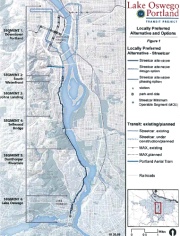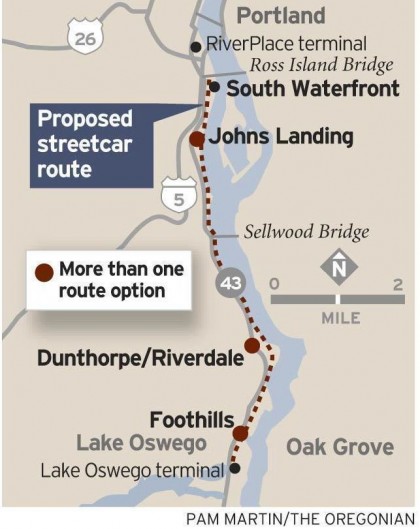
become a bicycle highway?
(Image: Metro)
After what the Oregonian called “persistent doubts from suburban taxpayers and a wealthy enclave of homeowners” the Lake Oswego streetcar project is on the rocks.
Concerns about construction and operating costs of the streetcar were the reasons for its demise, but over $2 million has already been spent on planning and impact studies.
Instead of throwing that money out the window, officials have an opportunity to build on the previous momentum for the streetcar and construct a world-class bike connection between Lake Oswego and downtown Portland.
Anyone who rides a bike between Portland and Lake Oswego knows that current options are lacking. Biking along Highway 43 is unpleasant and unsafe (Clackamas County might be improving bike access on it, but it won’t be game-changing). Other routes between the two cities’ downtowns are circuitous and include significant altitude gains.
Proposed routes for the streetcar have already been identified and the costs of building right of way along Highway 43 are known. The route identified for the streetcar would, obviously, be at an even grade and provide a direct connection for bicycles where one currently doesn’t exist.
I’ll be the first to point out that I’m not an engineer, but I think it’s safe to assume construction of a paved path would be cheaper than construction of train tracks. Maintenance and operating costs are also likely to be lower for a bike path than for the streetcar.
“The [streeetcar] route is perfect for a bike connection, isn’t it? Rail grading. Never more than 100 ft above the river. Awesome.”
— BikePortland reader Graham Ross
Some people might suggest the plan for a new connection between Lake Oswego and Portland should be scrapped completely to save tax payers’ money, but doing nothing would cause the region to miss out on a source of jobs and future revenue.
The streetcar line was the vital connection to the planned Foothills redevelopment district near the Willamette River and downtown Lake Oswego. Future development in the area was projected to bring in more revenue (in the form of property taxes) than it would cost to construct the streetcar. Development of the district and construction of the streetcar were projected to create as many as 6,000 new jobs.
Without the link provided by the streetcar the Foothills redevelopment project might be scrapped, along with revenue and jobs it would have created.
Constructing a bicycle corridor along the proposed streetcar route could help provide the transportation connection needed for redevelopment and would preserve revenue and jobs that come with it.
The possibility of using the streetcar route for a bikeway is already on people’s minds. BikePortland reader Graham Ross contacted us saying he doesn’t understand why there hasn’t been more public discussion about it already (emphasis mine):
“I’ve biked 43 both ways, which sucks, and I’ve climbed the Terwilliger and cemetery hills, which are lovely but strenuous. I know LO [Lake Oswego] is chock full of avid cyclists who work in Portland…The [streeetcar] route is perfect for a bike connection, isn’t it? Rail grading. Never more than 100 ft above the river. Awesome.”
Now the idea is officially out in the open.
Will officials seize the opportunity to build a world-class bike facility and foster economic development in our region? Or will they pass on the chance and leave the Foothills in the lurch?

